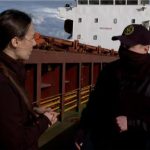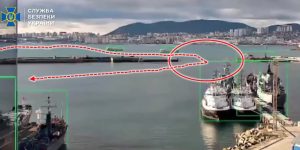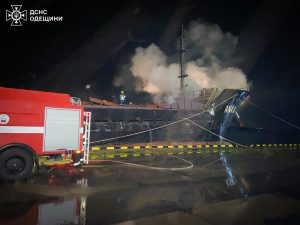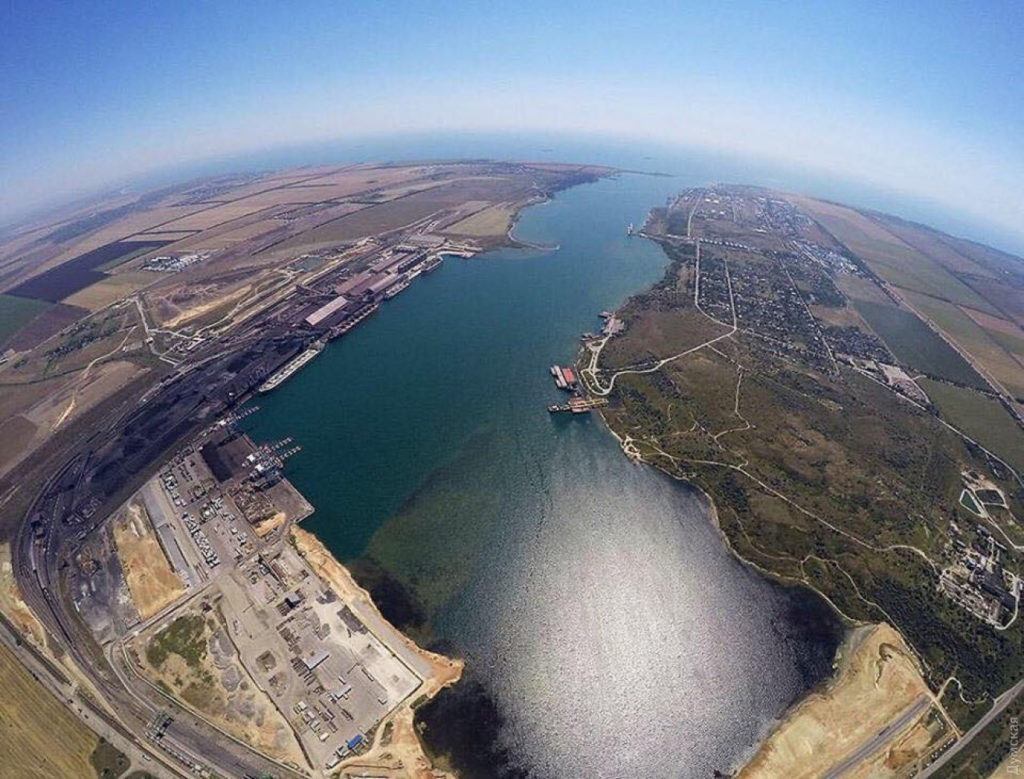The SBU told how they detained ships transporting stolen Ukrainian grain
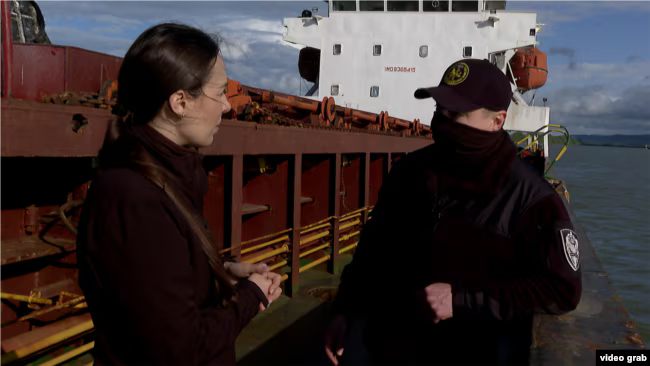
The Security Service of Ukraine told how they detained and arrested ships that were exporting stolen Ukrainian grain.
This is stated in the material of “Crimea.Realia”, which managed to get on the arrested ships.
The arrested dry cargo ships illegally entered the ports of the occupied Crimea and exported stolen grain from the occupied parts of the Kherson and Zaporizhia regions. The ships were detained in the internal waters of Ukraine. The shipowner of one of them is a Russian company, the other dry cargo ships are registered in the offshore zone. In order to avoid punishment for illegal actions, the captains destroy logbooks, turn off AIS, the ships sail under different flags and register under fictitious companies. Ukraine sells the arrested ships or transfers them to private companies for management.
For example, the dry cargo ship ANKA is under constant guard. One of the participants in the special operation to detain the vessel is an operational officer of the Main Department of the SBU in the Autonomous Republic of Crimea (his name and surname are classified). The operation was carried out jointly by the SBU and the maritime guard of the State Border Guard Service of Ukraine. The vessel was arrested in April this year.
According to the SBU officer, after contacting the crew, the vessel accelerated. Last year, when the SBU detained the USKO MFU vessel, it also accelerated after a request to stop and allow the vessel to be inspected.
The dry cargo ship ANKA was heading down the Danube towards the Black Sea after loading in the port of Moldova. It was detained in the waters of the port of Reni, Odesa region. According to the operative, they had only a few minutes and only a few nautical miles to stop the vessel and not violate the norms of international shipping.
The decision to arrest the vessel within the framework of criminal proceedings was issued by the Dniprovsky District Court of Kyiv. In November 2024, a dry cargo ship under the flag of Zanzibar illegally entered the port of Sevastopol in occupied Crimea. There, it was loaded with about 5 thousand tons of grain stolen from the occupied parts of the Zaporizhia and Kherson regions.
According to Yegor Rebrov, head of the department of the Prosecutor’s Office of the ARC and the city of Sevastopol, the investigating judge issued a ruling to arrest this vessel as a means of committing a crime, that is, violating the procedure for entering and leaving the temporarily occupied territory.
During the search, navigation equipment, ship documentation and evidence of stay in the closed port of occupied Sevastopol were found. Namely, quarantine certificates issued by the occupation authorities of Crimea. They state: wheat was transported from the occupied city of Melitopol in the Zaporizhia region and occupied Kakhovka in the Kherson region to the port of Sevastopol. The sender is a Russian company from Krasnodar. The place of delivery is Egypt. To avoid liability, the ship’s captain, flag, and even owner were changed before the Danube voyage. According to investigators, the shipowner’s company is registered in Montenegro. However, finding the ultimate beneficiaries in such cases is extremely difficult, the investigator added.
The captain of the ANKA vessel was a 43-year-old Indian citizen. The SBU reported him in absentia on suspicion of violating the order of entry and exit to the temporarily occupied territory. The man faces up to 5 years in prison. The document states that the captain periodically turned off the AIS system so that the vessel’s course could not be tracked.
An SBU operative said that at the request of the shipowners, the captains of such vessels began to turn off navigation equipment when approaching the occupied territory of Crimea. In addition, as they began to detain vessels and seize the relevant evidence base, they began to make not only changes, but even destroy ship logs.
Prosecutor Rebrov noted that during the occupation of Crimea, the Russian Federation developed a whole scheme for concealing the origin of the cargo. Phytosanitary certificates are often issued without specifying Crimea, or sometimes they write territories or ports without specifics, or they generally formalize it as passing control at the port of Kavkaz, Novorossiysk, that is, ports of mainland Russia.
The Russian authorities began to use Crimea as a logistics hub through its developed port infrastructure back in 2014, after the annexation of the peninsula. And since the beginning of the full-scale invasion through the Crimean ports, Russia has purposefully begun to export Ukrainian grain from the occupied territories. In 2023 alone, this will be over 2 million tons, said Kateryna Yaresko, a journalist for the SeaKrime project of the Myrotvorets center.
According to her, currently the export of stolen grain is accompanied by the registration of quotas. Companies that export grain register quotas, do not charge certain fees for export, etc.
“There is a NASA food program that comprehensively assesses food supplies in certain territories, in particular, they issue a report every year on grain harvested in the occupied Ukrainian territories. This is about 6-8 million tons. If 2 million tons through Crimea, there is partly much less through Berdyansk, Mariupol, then where is the rest? The rest, and there are certain signs everywhere that it is exported through Russian ports, that is, it is probably also transported by road, and now they have launched rail transport. If wheat is shipped there in the port, for example, “Azov”, then it is not a fact that it is Russian wheat,” – said Yaresko.
Investigators have identified several dozen vessels that illegally entered Crimea. The court has arrested more than twenty of them in absentia, but in fact only two vessels that were exporting grain were arrested, the prosecutor says.
One captain was detained and even convicted. This is a citizen of Azerbaijan, the captain of the USKO MFU vessel under the flag of Cameroon. He was arrested last year when the dry cargo ship passed through the mouth of the Danube River. It was established that the vessel was in Crimea twice. In 2023, it exported Ukrainian grain, and in 2024, it delivered gypsum. Kateryna Yaresko monitored its course. After leaving the Turkish port, the vessel turned off its automatic identification system, and two days later investigators noticed it moored in Komyshova Bay of occupied Sevastopol. Its stay in the port was recorded thanks to satellite images. In court, the captain made a deal with the investigation and pleaded guilty to violating the order of entry and exit to a closed port in occupied Crimea, the ruling says. The Shevchenkivskyi District Court of Kyiv ordered him to pay a fine of 102 thousand. hryvnias and banned from operating sea transport for two years. The captain’s name is not disclosed.
The owner of the vessel is a Turkish company. By court decision, the dry cargo ship was transferred to the National Agency for Tracing and Asset Management. The vessel is being prepared for sale at auction. The approximate value will be announced after its condition is assessed.
The head of the Southern Interregional Territorial Department of ARMA said that the vessel was built in 1981. It is quite old and many mechanisms require maintenance, and since the vessel was actually inoperative, that is, the vessel’s crew was removed, a detailed examination is required to determine the value estimate.
Read also: Sale of arrested ships: how the shipping market reacts to the work of ARMA
“An auction was held, respectively, on the Prozorro site, it was a successful auction, according to the results of which the sale price at the auction, indicated for an already practically unusable ship, reached three times the declared one, and this was a good result and direct revenues to the state budget. It was exhibited with the results of the assessment of the Prozorro site, the starting price is 2.5 million hryvnias, according to the auction results it is 6.5 million hryvnias,” said Deputy Head of ARMA Stanislav Petrov.
Crimea.Reali sent official requests to the companies registered as owners of the arrested ships, but did not receive any answers.
The bulk carrier EMMAKRIS III at the beginning of the full-scale invasion was blocked in the port of Chornomorsk, Odessa region. In the summer of 2022, the ship was arrested. Its owner is an offshore company registered in Hong Kong, and the operator is another offshore company in Dubai. However, the investigation established that the bulk carrier actually belongs to a Russian company from Rostov-on-Don, and it is related to the export of Ukrainian grain from Crimea. The vessel sailed under the Panamanian flag, but now it is flying the Ukrainian flag.
The estimated cost of the vessel is over UAH 100 million. ARMA transferred the bulk carrier to the management of a Ukrainian private company. Under the terms of the contract, the vessel is prohibited from leaving the port, because in any other country the Russian owner can try to return the bulk carrier back. In addition, the management company must pay a part of the profit to the country’s budget every month. Stanislav Petrov clarified that the company transfers over 81% of the profit to the state budget, and keeps about 19% as a reward.
USM previously reported that the Russian Federation is suing Syria over grain that it itself stole from Ukraine — details of the grain lawsuit.
